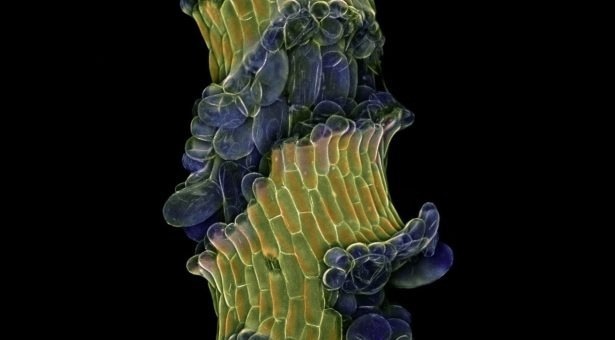An obscure aquatic plant has helped to explain how plants avoid cracking up under the stresses and strains of growth.
 Arabidopsis stem with weakened cell adhesion treated with an inhibitor of the growth hormone brassinosteroid, which slows epidermal growth, causing mechanical stresses and opening cracks as epidermal cells are pulled apart. Image Credit: Hand-coloured confocal image courtesy of Rob Kesseler and Robert Bellow
Arabidopsis stem with weakened cell adhesion treated with an inhibitor of the growth hormone brassinosteroid, which slows epidermal growth, causing mechanical stresses and opening cracks as epidermal cells are pulled apart. Image Credit: Hand-coloured confocal image courtesy of Rob Kesseler and Robert Bellow
An interesting observation was made in a dwarf mutant of the carnivorous plant Utricularia gibba, which led Dr. Robert Kelly-Bellow and Karen Lee, researchers with Professor Enrico Coen’s team at the John Innes Centre, to their discovery.
This floating plant’s stems are hollow and filled with airspaces, which causes the vascular column inside to buck under pressure. Due to their sturdy stems, most plants would not exhibit this effect.
The central column of a dwarf mutant was seen by the researchers to be wavy rather than straight. They postulated that a conflict between internal events in the plant stem and the epidermis, or skin, was the root cause of the swaying spine.
Study co-author Dr. Richard Kennaway’s computational modeling demonstrated how this theory could explain the results.
We realized that in these types of dwarfs, only the epidermis, the skin of the stem, wants to be short, the internal tissue still wants to be long hence the buckling effect. This was a surprise—previously people had thought that dwarf varieties, which are very important in agriculture, would be dwarf because everything in the stem is affected to grow less but in fact it is just the skin in this case, creating a sort of straitjacket.
Enrico Coen, Study Author and Professor, John Innes Centre
Further research indicated that the brassinosteroid growth hormone was absent in the Utricularia gibba dwarf mutant.
According to their hypothesis, this hormone generally causes the epidermis to stretch, providing a more forgiving straitjacket and enabling the plant stem to lengthen.
They tested this theory by using a mutation in the model plant Arabidopsis that weakens the bond between cells to determine if lowering brassinosteroid would result in the pressures causing significant cracks to appear in the skin of the stem.
Coen added, “That is exactly what we saw. Normally an Arabidopsis stem with weakened glue will crack slightly because the hormone is there to loosen the straitjacket. But when the hormone was missing, the skin was completely ripped off and the plant was almost skinless.”
Study co-author Professor Richard Smith’s computational modeling revealed that the brassinosteroid hormone was likely relieving the straitjacket by freeing fibers in the epidermal cell walls.
“Plant cells are stuck together and are forced to behave in a coordinated way just by their pectin, their glue, that binds them. What we show in this study is that this is an incredibly powerful force; the glue is so strong you only need to change growth in one layer and the other cells will follow,” Coen further stated.
He continued, “Previous studies have emphasized that plants send molecular signals to grow in a coordinated way, and this is still a part of the explanation. But what our study shows is that the glueyness of plant cells is also a vital component in coordinating growth. Sticking together is very important.”
Study co-author Dr. Christopher Whitewoods at the Sainsbury Laboratory, Cambridge University, stated, “The fact that mechanical interactions between cell layers control growth in the stems of two wildly different species raises the question of whether they control other aspects of plant development, such as the complex internal patterning of leaves. We are excited to test whether this is the case.”
The findings provide insight into dwarfing varieties of crops like wheat and rice, which are at the heart of agriculture’s Green Revolution, showing how genes influence their growth and how to improve their efficiency in the future.
The finding also applies to animal developmental processes, including the shape of the intestine and the production of crocodile skin fissures, where mechanical interactions between layers are also believed to be important.
Many theories start off looking good but fall short of holding up during the course of an experiment. Professor Coen argued that this is not the case here.
Coen further added, “The first glimpse of the wobbly tissue in our dwarf aquatic plant was exciting because as soon as we saw that, we had an idea of what might be going on. But the biggest excitement came from testing the idea in a completely different system. Nature is elusive. Ninety-nine percent of nice ideas fall flat on their face when put to a critical test. But occasionally an idea survives and you then know that nature has revealed one of its secrets to you.”
The first author of the study Dr. Robert Kelly-Bellow added, “Exploring a mutant in a carnivorous plant was a great opportunity. At first, we were interested in the traps and the dwarf mutant had only a very subtle phenotype. Only by looking under its skin did we uncover something that led us down a completely unexpected path.”
Source:
Journal reference:
Kelly-Bellow, R., et al. (2023). Brassinosteroid coordinates cell layer interactions in plants via cell wall and tissue mechanics. Science. doi.org/10.1126/science.adf0752